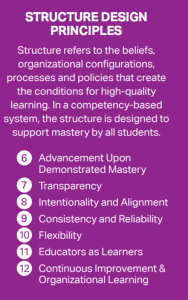7 Structure Design Principles to Ensure High-Quality Competency-Based Systems
Education Domain Blog
 This is the eighth post in the blog series on the report, Quality and Equity by Design: Charting the Course for the Next Phase of Competency-Based Education.
This is the eighth post in the blog series on the report, Quality and Equity by Design: Charting the Course for the Next Phase of Competency-Based Education.
Structure refers to the arrangement of, and relationship between, the elements of a system. It is the policies, processes and practices that influence decision making and the daily operations of a school. In a competency-based system, the structure is designed to support mastery by all students. In a previous blog in this series, we introduced 16 Quality Design Principles as a common reference point for dialogue about what makes a competency-based system high quality. The 16 Quality Design Principles are organized into three categories: Culture, Structure and Teaching and Learning. In this blog, we explore the 7 Quality Design Principles related to Structure.
7 Quality Design Principles for Structure
Structure is composed of the beliefs, organizational configurations, processes and policies that create the conditions for high-quality learning. Here are 7 Quality Design Principles for ensuring high-quality competency-based systems relating to structure:
 1. Advance Upon Demonstrated Mastery
1. Advance Upon Demonstrated Mastery
When students advance upon demonstrated mastery, not the passage of time, educators direct their efforts to where students need the most help and make sure they learn the skills they will need in more advanced courses. Advancement upon mastery replaces the practice of promoting students, despite gaps in their knowledge and skills.
The practice of advancing upon mastery is grounded in research on motivation, engagement and learning. Students are more engaged and motivated when grading is seen as feedback that helps them focus on what they need to work. As a result, students may spend more time working in those areas that are more difficult for them. They may even advance beyond grade level in some academic domains, while more instruction is available to progress in those areas that are more challenging. Policies and processes organized around student advancement based on demonstration of mastery include: multiple opportunities and methods to demonstrate learning; targeted and timely instruction; coaching that supports students as they strive for the next level of mastery; transparent feedback and grading practices; and monitoring pace and progress.
The continuum of student learning objectives, performance, growth and progress are transparent to all. Transparency of teaching and learning philosophy also facilitates student ownership and builds intrinsic motivation for students. When adaptive leadership is combined with greater transparency, organizational decision-making processes can increase participation and generate trust. As a result, everyone can be actively engaged in the process of continuous improvement and empowered leadership.
 3. Seek Intentionality And Alignment
3. Seek Intentionality And Alignment
Quality competency-based schools require intentionality to ensure that every part of their districts and schools are designed to support student learning. There are clear reasons for each choice in the design and operations of a school, and each choice supports alignment with the school mission. Instruction, assessment and learning experiences (curriculum) are aligned with the appropriate depth of knowledge of standards. When making decisions, adults ask the question, “What’s best for kids?” to ensure that there is alignment with the learning sciences.
 4. Establish Mechanisms To Ensure Consistency And Reliability
4. Establish Mechanisms To Ensure Consistency And Reliability
A competency-based system is organized around the objective that students advance upon demonstrated mastery of learning objectives. In order to do so, those learning objectives must be clearly articulated and reliably understood by all. Learning objectives must be calibrated within the school and across the district. By creating cross-district and cross-school calibration, the variability in expectations will be reduced. Transparency of those learning objectives and creating a shared understanding of what proficiency looks like is critical to building trust in teachers and between students and teachers.
 5. Increase Organizational Flexibility
5. Increase Organizational Flexibility
Schools require autonomy to be responsive and flexible to meet student needs. Once we know where students are in their learning, it is incumbent upon a competency-based system to respond in ways that will engage, motivate and provide the needed instructional support. This adaptability requires a flexible structure. The organization of districts and schools enables educators to respond to students with personalized and differentiated strategies. Environments and time are flexible — students receive more instructional support when they need it and learning may take place in the classroom, online, in the community or the workplace. Instructional strategies are also flexible and may call for direct instruction, small groups or project-based learning. Teachers have autonomy to organize tools and resources, including hands-on and online instructional strategies.
 6. Invest In Educators As Learners
6. Invest In Educators As Learners
Educators are active learners in a quality competency-based system. The practitioner shifts from “teacher” to researcher, designer, diagnostician and expert facilitator of constructive learning experiences. There exists regular opportunities to develop professional expertise that responds to a combination of goals and areas of need, informed by the progress of their students. When teachers are active learners, they reinforce and contribute to the culture of continuous improvement.
 7. Develop Processes For Ongoing Continuous Improvement And Organizational Learning
7. Develop Processes For Ongoing Continuous Improvement And Organizational Learning
Quality competency-based systems model the learning orientation that they seek to foster in students. District and school leaders use continuous improvement to challenge bias and inequitable practices, redirect resources toward students who need more support, and are constantly engaged in testing out new ideas that can improve overall learning and school performance. The structures in place support educators’ abilities to respond to student learning, support professional learning, and organizational improvement based on the pace, progress and growth of students. Assessment is part of the cycle of learning: It is intentionally incorporated to deepen understanding of content as well as strengthen critical skills that empower learners to seek out and engage with content more deeply, meaningfully and productively.
The next blog in this series will explore the 4 Quality Design Principles relating to Teaching and Learning, which refers to a theory and practice of teaching and learning that is based on the learning sciences and is shared across a school. It includes approaches to and uses of assessment as a critical ingredient to responsive teaching. Follow this blog series for more articles charting the course for the next phase of competency-based education, or download the full report:
- CompetencyWorks Releases New Report on Quality and Equity by Design: Charting the Course for the Next Phase of Competency-Based Education
- Readiness for College, Career and Life: The Purpose of K-12 Public Education Today
- Why A Competency-Based System Is Needed: 10 Ways the Traditional System Contributes to Inequity
- How Competency-Based Education Differs from the Traditional System of Education
- Competency-Based Education and Personalized Learning Go Hand-In-Hand
- Building Shared Understanding of Quality through Design Principles
- 5 Quality Design Principles for Culture in Personalized, Competency-Based Systems
